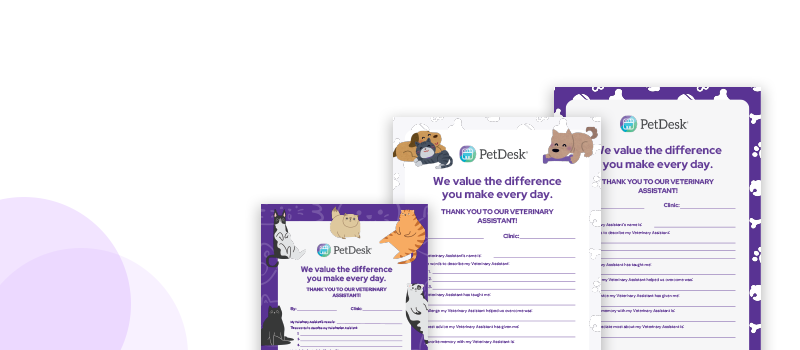For veterinary practitioners who are part of this sample, you’ve got your work cut out for you. Researching new technology is difficult. In fact, with the number of options available, you’re bound to leave your research phase a bit perplexed as for which direction to go. Thankfully, we’re here to help. And, while the end decision ultimately falls on you and the needs of your practice, we think a breakdown of the two can help you in your journey.
Without further adieu, let’s take a look at our breakdown.
At a high-level, there are two types of apps in the vet space. There are:
- Business-centric apps
- Client-centric apps
Let’s start with the first.
Business-centric apps are what we refer to as “white label apps”. What’s a white label app? It’s an app built by another business for your business. While the core functionality of the app will remain the same between businesses that purchase the app, the name itself will change along with other branding changes as requested.
It’s a great way to brand your business. For marketing purposes, it’s certainly a nice feature to have. Users will always have your clinic’s name front and center on their smartphone.
Client-centric apps are geared towards — you guessed it — clients. Rather than being designed for a particular business, client-centric apps are designed with the end user in mind. It’s an important distinction to make because white label apps are used in different industries and aren’t necessarily tailored to the needs of a user within a particular industry.
If you’re a practitioner out there, you’d probably go with the one for your business, right? Well, not necessarily. Ask yourself, “Who’s going to use the app?” By extension, what are their reasons for using it?
While those are questions only you can answer, it’s important to think them over.
Now that we have a better idea of the two, let’s dive into the breakdown:
Client-Centric Pros
- Higher adoption rate
- Added-functionality (To-Do list, medical records, etc.)
- Customizable (services offered by the clinic, rewards programs, etc.)
- Designed for client needs, not clinic needs
- Regularly updated UX/UI in line with modern app designs and standards
- Multiple businesses may use the app instead of one (groomer, boarder, etc.)
Client-Centric Cons
- Expensive
- Must be used as part of or in conjunction with a reminder system
- Limited clinic branding
Alright, let’s go over a few things here. Client use and adoption rate — these are the big ones.
You want people to use your app. To do that, they have to download it. How does this happen? Well, there needs to be a tangible use and it needs to keep them coming back for more. Think of the apps you personally use frequently. There’s probably a few reasons to use each app that keeps you coming back.
Now, take a look at your average veterinary app. If you can do more than request appointments, like check medical records or schedule grooming appointments, then you’re more likely to use it. It’s that simple. With a reason to use the app more than once or twice a year, your clients are more likely to not only download your app, they’re more likely to keep it!
Client-centric apps are typically created to drive use and have widespread adoption because of this.
Business-Centric (White Label) Pros
- More affordable
- Custom clinic branding
- Customizable features (rewards punch cards, etc.)
- Separate from reminder system
Business-Centric (White Label) Cons
- Low adoption rate (Google Play Store / Apple Store)
- Limited focus on user experience
- Designed to serve clinic needs, not client needs
- Outdated UX/UI
- Infrequent updates
- Limited use (can’t use with a groomer, boarder, etc.)
- Limited use (request appointments/rewards punch card)
Alright, let’s break this one down. While adoption rates are typically lower with business-centric / white label apps, the marketing opportunity is certainly attractive. Since you’re able to name the app after your business, your clinic name is right there on your client’s phone. You’re essentially putting your name and app right next to Facebook, Instagram, and any other app out there. It’s something only a professional and well-established company is able to effectively do. Also, it’s excellent for building your brand.
The downside of this? You really need to do your part to get people on the app. Internal promotions, fliers — you name it. As we previously mentioned, you’re facing an uphill battle competing for space on the client’s phones. People don’t typically hang onto local business apps these days.
While there’s much more than this guide presents, it should offer you a decent idea of which direction you should go. In the end, you need to decide what’s best for you.
Every clinic is wildly different from the next. Ask yourself what’s best for you and your clients. If branding and affordability are right for you, then, by all means, check out one of the white label / business-centric options out there. If you’re interested in crafting the ideal customer experience, then a client-centric app may be what’s best for you. Lastly, ask yourself how your app will fit into your client acquisition/client retention strategy.
As always, feel free to request a demo if you’re interested in checking out PetDesk.
See the power of PetDesk for yourself—for free
Save time and grow your business with custom websites and digital marketing, 24/7 error-free booking, a PIMS-VoIP phone system, plus a client engagement platform with a mobile app.










